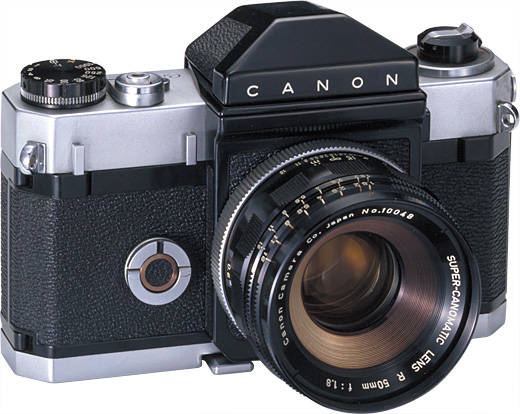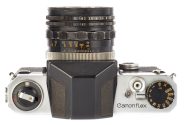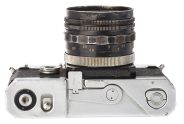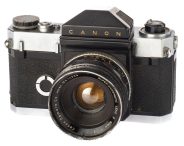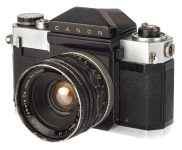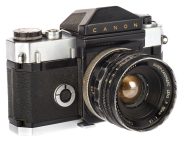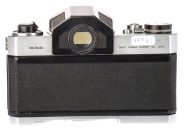Canonflex
35mm MF film SLR camera
Specification
| Production details: | |
| Announced: | May 1959 |
| System: | ● Canon R (1959) |
| Format: | |
| Maximum format: | 35mm full frame |
| Film type: | 135 cartridge-loaded film |
| Mount and Flange focal distance: | Canon R [42mm] |
| Shutter: | |
| Type: | Focal-plane |
| Model: | Mechanical |
| Speeds: | 1 - 1/1000 + B |
| Exposure: | |
| Exposure metering: | None |
| Exposure modes: | Manual |
| Physical characteristics: | |
| Weight: | 940g |
| Dimensions: | 145x100x49mm |
Manufacturer description #1
The unprecedented CANONFLEX is the highest achievement in the 20-year history of Canon. Behind it are the unique experience and skill of Canon's unsurpassed design, engineering, and construction staffs.
The Canonflex is made for the professional, as well as the discerning amateur - for all photographers who want to record a picture with the same clarity and ease as the naked eye. After you release the shutter, the automatic lens diaphragm springs back to full aperture and the automatic mirror springs back to open position to disclose with full brightness the scene you have just photographed. In addition to this Canon-exclusive feature, the Canonflex is the only single-lens reflex camera in the world with the detachable exposure meter (Canon-Meter R) coupled to the speed dial automatic, dual strobo-flash synchronization socket anti-film curl roller trigger-action lever These, and many other, superb features of the Canonflex are proof positive that it is the world's foremost single-lens reflex camera.
The eye-level ease with which the Canonflex is used may be summed up in the words "quick-as-a-wink." Fast trigger-action lever! Even in the most difficult situations, you can rely on the Canonflex to give you the picture you want.
The new Super-Canomatic Lens R has the unexcelled quality of all Canon lenses, and guarantees pictures of the utmost clearness and critical sharpness. When you release the shutter, the diaphragm closes automatically to the pre-selected aperture stop then reopens automatically to full aperture immediately after exposure. No parallax problems ever with the Super-Canomatic Lens R or any of the many interchangeable lenses that can be used, as the object is always viewed through the taking lens.
Canon-Exclusive Super-Canonmatic Lens R 50mm f:1.8 (with Automatic Springback Diaphragm) Fully Synchronized with Automatic Spring back Mirror
Canon-exclusive, springback mirror, fully synchronized with the Super-Canomatic Lens R, is actuated by the shutter. As the shutter is released, the mirror flips up and returns automatically to the original position immediately after exposure. This action enables you to view the scene continuously. No "blackouts" with the new Canonfiex.
The Canon-exclusive, Super-Canomatic Lens R (with automatic springback diaphragm mechanism) is pre-set to a desired diaphragm opening. You can view and focus at full aperture (full brightness). As the shutter is released, the diaphragm closes to the pre-selected aperture stop, and then automatically reopens to full aperture immediately after exposure. This feature is a "must" for picture taking under poor light conditions.
In order to see the depth of field, when needed, the visual aperture ring can be operated manually to disclose the exact depth of field of the pre-selected aperture. This is impossible with the rangefinder-type camera. It is important, however, to set the visual aperture ring back to full opening before the shutter is released.
Canonflex, Split-Image Type Range-Viewfinder
The Canon-exclusive. Echelette (patented) split-image type range- viewfinder, the brightest of any on today's market, is incorporated into the Canonflex single-lens reflex system. A double concentric makes it doubly simple to match the range- finder lines for extreme accuracy.
For convenient focusing, the frosted surface of the rangefinder can be used. For more critical focusing, the split-image rangefinder lines should be used. As soon as the split-image appears in perfect alignment, the lens is critically focused.
Canon-Exclusive, Eye-Level Pentaprism, Interchangeable with Waist-Level Viewer
For ease in picture taking, viewing and focusing is done normally with the eye-level pentaprism viewfinder. The eye-level pentaprism is interchangeable with the accessory waist-level viewer (4 X magnification). You can choose either viewfinder depending on your need.
Thru-the-lens focusing of the single-lens reflex system eliminates all the problems of parallax usually associated with twin-lens reflex or rangefinder-type cameras. You are absolutely free of parallax at all time with any lens used. What you see through the viewing and focusing eyepiece is what you record on film. You get edge-to-edge, naked-eye-clear-and-sharp pictures every time! No cutting off heads or feet!
Canon-Exclusive, Motor-Speed Trigger-Action Lever
A single-stroke of the Canonflex trigger-action lever advances the film, cocks the shutter, counts exposures in one operation. Simultaneously, it readies the springback diaphragm and mirror for picture taking.
You can take as many as 3 pictures per second! The lever cannot be wound unless the shutter is released.
Canonflex, Detachable, Canon-Meter R Coupled to the Shutter Speed Dial
The Canon-Meter R is coupled to the shutter speed dial of the Canonflex. It is attached to the accessory clip on the front of the camera body and can be detached for use separately. Canon-Meter R has the highest sensitivity in spite of its small size. The sensitivity knob has white and orange marks. The white mark is for an object in bright light (when low sensitivity is needed). The orange mark is for an object in poor light condition (when high sensitivity is needed). The Canon-Meter R has such a high sensitivity that it will work for an object having light value as low as 4 (LV 4). This means that the meter will work even in poor light condition where you have to use 1/4 sec. with an f 1.2 or 1/2 sec. with an f 1.8 using ASA 100 film. No other light-meter among similar types can match Canon unless combined with attachment. Using ASA 100 film the sensitivity range of Canon-Meter R is
Low Sensitivity Range - Light Value - 10-19 lumen
High Sensitivity Range - Light Value - 4-13 lumen.
When the meter indicator is turned to match the pre-set aperture reading the shutter is automatically set to the correct exposure time. Conversely if the shutter speed is first set, the correct lens aperture will automatically be determined. The Exposure Indicator Dial is calibrated in both ASA and DIN. An incident light attachment is provided with the Canon-Meter R.
Easy-to-Read, Film-Type Reminders
The film-type reminder of the Canonflex surrounds the film rewind crank, which is on the top (left side) of the camera.
ASA and DIN indicators constantly remind you of the speed changes. Three marks are also incorporated on the film-type reminder disc to show the type of film with which the camera is loaded; black and white, daylight- type color, or tungsten-type color.
The film-type reminder is set manually with selector rings, which are revealed when the rewind crank is lifted up.
Canonflex, Automatic Exposure Counter
The film exposure counter which indicates the number of exposures, returns automatically to "s" (starting) position whenever the back cover of the camera is opened. One frame is advanced as the shutter is cocked. Numbering starts from zero.
Canonflex, Single-Pivot, Rigid Shutter Speed Dial
The shutter speed dial, with its equal, linear spacing, and click stops, is on a single pivot, with 11 speeds ranging from 1 second to 1/1000th of a second plus B (bulb)-T and X for strobo-flash synchronization. T (Time) exposure does not require resting your finger on the shutter release button for any length of time. Simply shift the time lever! The shutter will stay open until the time lever is returned to its original position.
Canonflex Built-in Self-Timer
Built-in self-timer of the Canonflex, which allows you to get in the picture, is the shutter button type. Canon's unique shutter-release button system eliminates confusion between ordinary and time exposures. Cable release hole is provided. Maximum delay of self-timer is 10 seconds.
Canon-Exclusive, Cordless, Automatic, Single-flash Socket for Dual Strobo and Flash Synchronization
Either BC flash unit, or electronic flash unit, is fitted directly to the single, bayonet-fitting socket on the camera. The circuit is automatically connected as the unit is attached eliminating the use of exterior wiring. Use the specially fitted cam flash gun or any other standard flash gun. Extensions can be used, if desired.
The setting of the shutter speed dial automatically sets the synchro-mechanism with the shutter mechanism for accurate flash timing (adjustment of type M and FP bulbs). The new Canonflex can be used with any kind of flash bulb, or electronic flash, without any further setting or adjustment. X-1/60sec. FP 1-1/1000sec. M 1-1/250sec. F 1/35sec.
Canon-Exclusive, Anti-Film Curl Roller and Self-Loading Cassettes
Canon-exclusive, anti-film curl roller on the pressure plate prevents warping and curling of film, which assures critical and accurate focusing at full aperture of the highest speed lenses, where the depth of field is extremely shallow.
The new Canonflex takes either standard or Canon film cassettes (Canon Film Magazine V).
Interchangeable Lenses for The Canonflex
Canon lenses are held in the highest esteem by professional and discerning amateur photographers the world over for their unsurpassed, unique optical design, exclusive Spectra-Coating (TM), and precision engineering.
Canon pioneered development of high-speed lenses opening new field of photographic versatility to the serious photographer.
The unmatched interchangeable Super Canomatic lenses are designed and made to the same exacting quality standards as the famed Canon 35mm rangefinder-type camera lenses.
Before leaving the factory, all Canon lenses must meet rigid tests to insure the highest resolution, contrast, brilliance, and color fidelity in addition to the new- response-function testing method.
The Super Canomatic lenses have fully-automatic springback diaphragm. The front part of the Super-Canomatic Lens R serves as the sun shade eliminating the use of extra attachment. All Canon lenses, 85mm or longer focal length, can be used with the Canonflex, in combination with focusing adapter tele-coupler or tele-coupler and bellows focusing device, depending upon the focal length and the type of lens used. With focusing adapter, Canon screw-mount interchangeable lenses from 85mm to 135mm can be used with the versatile Canonflex. With Canon's tele-coupler R, and bellows focusing device their unique, lightweight, aluminum telephoto lenses from 200mm to 1000mm can be used with the new Canonflex.
Manufacturer description #2
The top-class 35mm camera market gradually shifted from rangefinder cameras to single-lens reflex cameras. The major reason was that SLRs could handle close-ups, photomicrography, duplication work, and other applications without being constrained by the limits of rangefinder camera lenses. When Canon introduced the Canonflex, its first SLR, there were already eight SLR models on the market.
The Canonflex used a high-quality, breechlock lens mount. The lens flange ring was turned to lock the lens onto the camera flange’s bayonet lugs. The lens flange and camera flange did not rub against each other like today’s lens mounts. The camera used Super-Canomatic lenses which had a fast, fully-automatic diaphragm. A 130-degree winding trigger at the camera bottom enabled quick film advance. An external selenium exposure meter could also be attached.
From the Classic Camera magazine (May 1999)
The Canonflex is a chunky and tough camera, designed and built with care and attention to detail and using many leading edge technical solutions, some of which, however, proved to be quite unpractical. The Canonflex had a horizontally running cloth shutter and a top speed of 1/1000s. It was designed to accept a clip on light meter and had an instant mirror return mechanism. The pentaprism was interchangeable, but the focusing screen was fixed and could not be replaced with other screens. In place of the traditional film wind lever, the Canonflex had a folding lever placed in the base plate, and the self timer lever at the front was replaced by a removable key.
Lenses were interchangeable, with an external bayonet mount and a locking ring placed on the lens barrel, but the automatic aperture control was achieved through two different mechanisms, one to close and one to open the iris. The fact that viewfinders were interchangeable was in fact purely theoretical, since the only alternative was a so-called rigid viewfinder which was useful for copies, but little else.
The external light meter was coupled to the shutter but not the aperture control, and this represented a small handicap which compounded that of the film wind lever on the base plate. The Canonflex camera body was square cut, similar in appearance to the Canon V and VI and to the successive Canon 7.
The mirror box was also square and the front, apart from the self timer key socket and the light meter bracket, was clean.
The pentaprism was solid, square cut and black. To the right of the top plate was a large black shutter speed selector knob, characterised by its knurled finish, devised to engage a gear in the coupled light meter. Next to the shutter speed control were the shutter release and the frame counter window.
On the opposite side, the film rewind lever crank was set into a film memo ring. The camera back was hinged to the side and was opened by means of a key in the base plate, while the synch socket was placed on the left hand side as in the rangefinder Canon.
The result of expert and careful design mutuated from the rangefinder cameras, the Canonflex displayed a few naive touches and was never the commercial success it deserved to be, also due to an inadequate marketing campaign.
The Canonflex remained in production for one year, from May 1959 to May 1960 and was made in 16,000 examples.
The commercial success of the Canon VI-L and the Canon P with the top plate positioned film advance lever, suggested nothing to Canonflex's designers, who offered the not so successful base plate mounted lever in the SLR, persevering even in the next two models, while the rangefinder models definitively abandoned this system with the Canon 7.
